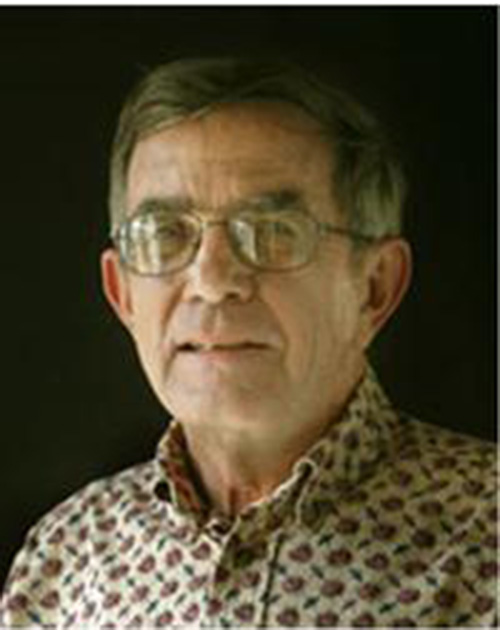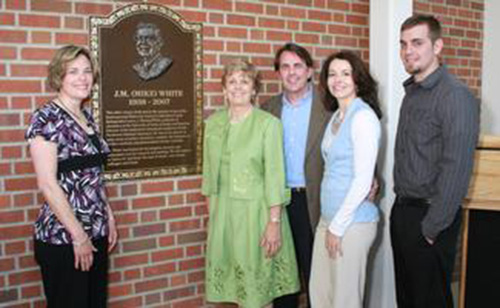J. M. White Endowed Presidential Fellowship in Chemistry
Charles T. Campbell and J. W. Rogers, Jr., former PhD students of J. M. White, committed funds in 2007 to create an endowed fund at the University of Texas at Austin for the J. M. White Graduate Fellowship in Chemistry. Funds distributed from the endowment provide support to graduate students of high academic achievement in the Department of Chemistry and Biochemistry, in accordance with the standard University and College fellowship selection process.
Mike White was born November 26, 1938, in Danville, Illinois, to Frances and John White. The oldest of the five children, Mike grew up on a prairie farm. He, his brothers Ben and Andy, and his sisters Ruth and Mary were raised with strong values and high standards. As a youngster, Mike understood the importance of hard work and education; his mother taught first grade to more than a generation of Danville children, and his father raised crops and hogs in the Illinois flatlands.

Those who knew Mike as a scientific powerhouse, a trusted mentor, and a superb teacher may be surprised to learn that he made his share of mischief in his early years. He and some high school friends had a long chat with the principal after they dangled a fellow student out a second-storey window. However, chemistry proved more appealing than a life of acrobatics, and upon graduation, Mike entered Harding College (now Harding University) in Searcy, Arkansas. There his lifelong interest in molecules was nurtured, as was his faith. There he met his wife-to-be, Gwen Combest. They married and moved to Urbana when Mike entered the graduate program at the University of Illinois.
One of Mike’s favorite stories, which he later shared with many struggling graduate students, dealt with failing six of seven qualifying tests in his first year at Urbana. Discouraged but not beaten, he determined that the school would have to ask him to leave before he would quit. Of course, he went on to pass the exams, and to fulfill the requirements for the doctorate in chemistry. He went on to build an academic career that was deep, broad, and productive.

W.A. Noyes, then chair of the Department of Chemistry at The University of Texas, visited Mike in his last year of graduate school. Noyes poked around labs looking for bright young chemists, and he found one that day. Mike liked to tell the story of that visit as an example of the importance of both preparation and serendipity. Noyes asked him about Badger’s rule, which Mike had just studied, so he passed the interview with flying colors. Some months later, Mike was named an assistant professor at UT, a title he held from 1966 through 1970, when he was promoted to associate professor and then, in 1976, professor of chemistry. Shortly afterward he served a four-year term as department chair.
Mike and Gwen raised three children in Austin. The eldest, Mark, is a Houston attorney; their daughter, RaeAnne, teaches and raises her family in Frisco, Texas; Paul, the youngest, is a graduate of Mike’s alma mater, Harding, and a talented songwriter, musician, and singer. In his last year, Mike took particular delight in hearing Paul’s music and helping him construct a recording studio at his home in Oklahoma City, Oklahoma.
In the 1990s, Mike engaged in interdisciplinary research centered on chemical issues related to the synthesis, growth, and analysis of electronic materials. Under his direction, a National Science Foundation Science and Technology Center (STC) was funded at UT bringing surface chemistry to bear on basic and applied problems that require collaborations among synthetic chemists, physicists, and engineers. As director, he led a team of twelve faculty, five postdoctoral fellows, and 25 graduate students from four departments in two colleges. The National Science Foundation recognized his eleven years of STC leadership with a Pioneer Award.
His other awards are numerous. Among his most treasured honors were being named to the Academy of Distinguished Teachers (2003) and receiving the Texas Blazers Faculty Excellence Award that same year. He was given both the Alpha Lambda Delta Outstanding Faculty Member Award and the Jean Holloway Teaching Excellence Award in 1998. Mike’s superb research was recognized by the American Chemical Society in 1990 with the Kendall Award and again, in 2001, with the Arthur W. Adamson Award for Distinguished Service in the Advancement of Surface Chemistry, and the 1999 University Cooperative Society Career Research Excellence Award.
An active force in the promotion and organization of science, Mike served as a program director for the National Science Foundation and as a member of the Seitz Committee on Major Materials Facilities of the National Research Council. He was on the advisory boards of several journals, including the Journal of Materials Research and the Journal of Physical Chemistry. In 2004, Mike began a joint appointment with Pacific Northwest National Laboratories, where he established and served as director of the Institute for Interfacial Catalysis until his passing.
Mike was uninterested in fame in a grand sense but he frequently expressed the hope that he would be famous with his students. In fact, his most significant service to surface science came through students that he has trained. Over 50 PhD recipients emerged from his busy laboratories, many of whom have established their own impressive list of contributions to surface science. He sought out bright undergraduates in the dozens of freshman chemistry courses he taught and introduced them to laboratory research. He mentored motivated learners at all levels, sponsoring a program (now embedded in the Austin Independent School District) for East Austin elementary school children and anonymously assisting needy college students with textbooks and tuition.
Mike was guided by and gave generously to his church, the Brentwood Oaks Church of Christ. He shared his powerful faith, strength, and hope with willing listeners. He seamlessly combined his roles as a Christian and a scientist in a way that instilled respect and love in all who knew him. Mike passed away suddenly and unexpectedly on August 31, 2007, in Oklahoma City, where he and Gwen were visiting their son. He is survived by his wife Gwen; his children, Mark and wife Melissa, RaeAnne and husband Todd Landrum, and Paul; his grandchildren, Melody and Carter Landrum; his mother, Frances White of Danville, IL; and his four siblings.
As a memorial, the Department of Chemistry and Biochemistry has established the John M. White Graduate Fellowship in Chemistry. Mike will forever be remembered by the family, students, friends, and colleagues whose joy it was to share his time on earth.
How to Give
Learn more at giving.utexas.edu
Search Endowments
Look for inspiring stories
